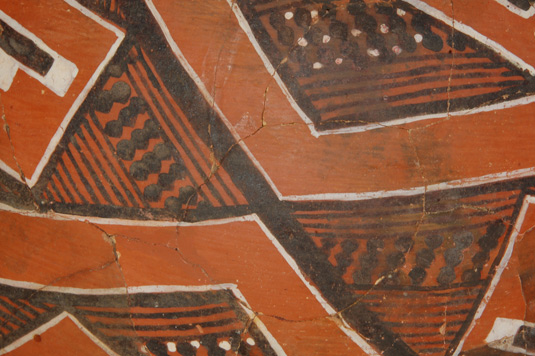Prehistoric Four Mile Polychrome Pottery Bowl [SOLD]
+ Add to my watchlist Forward to Friend
- Category: Pre-Columbian or Prehistoric
- Origin: Prehistoric Culture
- Medium: clay, pigment
- Size: 10” diameter x 4-1/2” deep
- Item # C3483D SOLD

Four Mile Polychrome pottery classification is a subset of what has been classed as White Mountain Red Ware, a class of pottery that was the most abundant and had the largest distribution of all Southwest painted ceramic types made between AD 1175 and 1450. These were produced in the Cibola district west of Zuni Pueblo.
“The final evolutionary stage of White Mountain Red Wares is witnessed in the advent of Four Mile Polychrome (ca. A.D. 1300 to 1400) when white paint was incorporated into design elements on the interior of bowls and on the exterior of vessel forms. Innovative asymmetrical compositions were also developed in Four Mile, and design elements such as mosquito bar hatch fill and negative painting borrowed from Kayenta ceramic types became common . . . Four Mile Polychrome are found in concentration below the Mogollon Rim between Cherry Creek on the west, Cedar Creek on the east, and southward nearly to the upper Salt River. This concentration is east of the Tonto Basin and Salado heartland.” Moulard, 2002
Condition: the condition, as expressed in documentation to the purchasers in 1995, is “excellent, reglued only.”
Provenance: from the collection of a family from Cincinnati.
Documentation: The Statement of Release and Disclosure provided by the seller to the buyer in 1995 states: Lovely polychrome bowl, very fine geometric designs has not been stolen, falsified, forged, or restored (without being so stated), and further that this item has not been excavated, purchased, traded, or sold in violations of 1) Federal Antiquities Act of 1906, 2) Archaeological Resource Protection Act – 1979 – (Indian reservations, B.L.M., National Forest, National Parks, etc.), 3) State Archaeological source protection Acts (to include all state lands), or 4) State imposed regulations to archaeological excavations on Private Deeded Property, and further that the seller or consignor of the above described materials has legal title to the property, such that, legal title transfers to and vests in the ultimate purchaser of the property. Signed by Indian Trader West, Santa Fe, 1995
CLIENT COMMENT: The following information was provided to us by a client who certainly is more knowledgeable than this staff on prehistoric pottery. We reprint his comments with his permission.
"This one I would describe as a very late Pinedale Polychrome with an exterior transitioning to Four Mile style, making a 1320 date attribution reasonable. It probably was produced somewhere in the White Mountains of eastern Arizona. While the trader's attribution typed the bowl as a Four Mile bowl from around 1200, it is rather well settled that the Four Mile style originated in the White Mountains in the vicinity of modern day Springerville and Point of Pines around 1325 and was produced until sometime after 1400. This bowl has its interior in the Pinedale style that was produced in the same vicinity between 1275 and 1325 and evolved into the Four Mile style. The exterior of the vessel has vertical black lines which break up the exterior design into panels. This is a transition from the lozenge figures on the exterior of Pinedale vessels and the concentric horizontal banding and linear white designs characteristic of Four Mile ceramics. Four Mile interiors mark a departure from the geometric patterns that (with some exceptions like classic Mimbres ware) dominated Native American ceramic design prior to the emergence of the Katchina cult late in the 1200s. Four Mile bowl interiors trend to feature asymmetrical assemblages of abstract figures symbolizing clouds, thunderbirds, pueblos, etc. that occupy the entire interior of the bowl, leaving no circular area undecorated at the center of the bowl interior as was the case with the earlier Wingate and St. Johns styles of White Mountain Red Wares."
Referenced Material: Re-Creating the Word: Painted Ceramics of the Prehistoric Southwest by Barbara L. Moulard, 2002

- Category: Pre-Columbian or Prehistoric
- Origin: Prehistoric Culture
- Medium: clay, pigment
- Size: 10” diameter x 4-1/2” deep
- Item # C3483D SOLD



